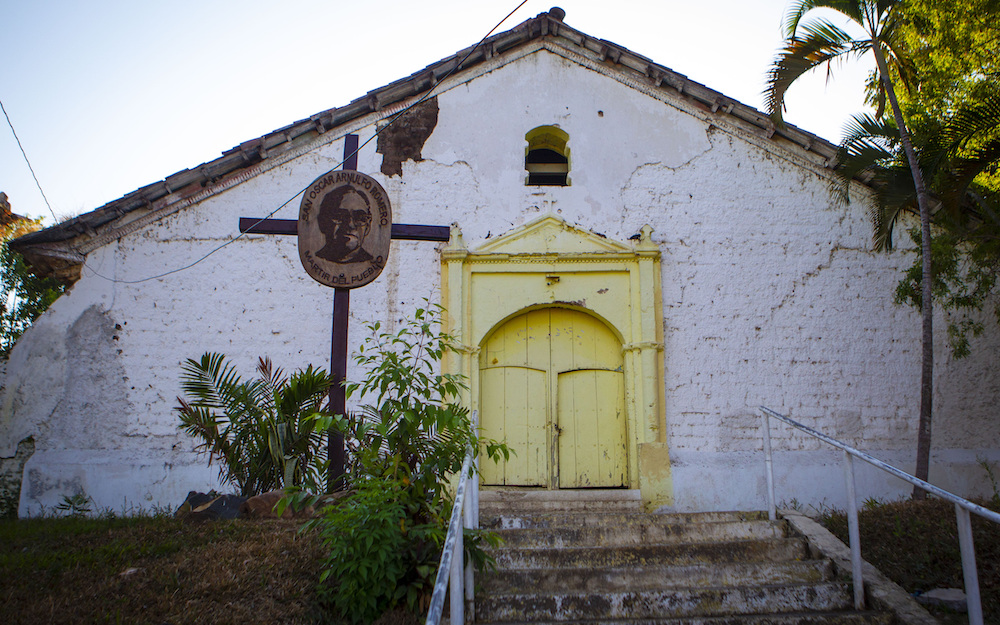Even before St. Oscar Romero became a saint Oct. 14, his native country of El Salvador saw an increase in tourism attributed to pilgrims or those wanting to know more about his life and death.
Figures from El Salvador's Ministry of Tourism say a "considerable number" of the 1.8 million tourists to the country who traveled there in 2013 went "exclusively to learn about the places where Oscar Arnulfo Romero lived."
After his canonization, the Archdiocese of San Salvador published a list of towns and cities for those interested in learning more about El Salvador's first saint. The list includes San Salvador, the country's capital, where many tours about St. Romero begin and end.
Many pilgrims make a stop at the Metropolitan Cathedral of San Salvador, where the saint is buried in the crypt. His tomb is covered by a bronze sculpture, made by Italian artist Paolo Borghi; the sculpture depicts St. Romero as if he were sleeping while guarded by the four evangelists, with a red jewel representing his heart. If you visit the cathedral, it's worth taking a look at Plaza Barrios outside, facing the facade, which became the setting for a chaotic scene during St. Romero's 1980 funeral, when many were trampled after an explosion that sent mourners running for safety.
The capital also is home to the chapel of Divine Providence Hospital, the place where St. Romero was martyred March 24, 1980. Visitors have easy access to the altar and the floor where St. Romero collapsed; it is now covered with a protective glass. The chapel is a short walk to the small residence where St. Romero lived the last years of his life and functions as a free museum that holds a trove of relics, including his car, clothing, a typewriter, a tape recorder he used to record his diary, books, personal documents such as a passport, driver's license, notes and a drawing of his friend, Jesuit Father Rutilio Grande, whose killing, some believe, inspired a great change in the saint.
While the locations in San Salvador are accessible by taxi or Uber, it's advisable to rent a car to get to the more remote locales outside of the capital city. Though El Salvador is small, about the size of Massachusetts, it takes time to get to less-traveled places because of the condition of the roads and because directions are not clearly marked. A paper map or the Waze application helps navigation toward the more remote cities of Ciudad Barrios and San Miguel in eastern El Salvador, which also are of great interest to pilgrims.
San Miguel, about two-and-a-half hours outside of San Salvador, is where St. Romero lived and served for more than 20 years. The Cathedral of Our Lady Queen of Peace, also known as the Cathedral of San Miguel, is in the bustling city center and has a large statue of the Salvadoran Madonna, to whom St. Romero had a special devotion. It's the place where many Salvadorans make a trek to venerate the Madonna. During his time there, St. Romero helped revive and inspire local devotions to the patroness of El Salvador, and now a large portrait of the Salvadoran saint hangs near her.
Another hour by car, to the north of San Miguel, is Ciudad Barrios, where the saint was born. In the city center's main square is where St. Oscar Romero Church, its main church, is located, as well as the home where he was born. The two-story structure has a chapel dedicated to St. Romero. Outside of the chapel hang depictions of what the house would have looked like when he lived there during his childhood, as well as some renditions of Ciudad Barrios in the past.
Though not located in the city center, Iglesia de Roma, an old church where the saint was baptized and where he celebrated his first Mass, is within walking distance of St. Oscar Romero Church.

